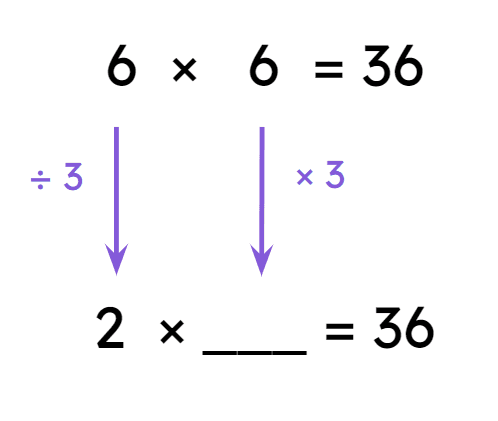Myths about teaching can hold you back
- Year 6
Explain the effect on the product when scaling the factors up and down by the same amount
I can scale factors up and down by the same amount and explain the effect.
- Year 6
Explain the effect on the product when scaling the factors up and down by the same amount
I can scale factors up and down by the same amount and explain the effect.
These resources were made for remote use during the pandemic, not classroom teaching.
Switch to our new teaching resources now - designed by teachers and leading subject experts, and tested in classrooms.
Lesson details
Key learning points
- When one factor is scaled and the other is scaled down by the same amount, the product remains the same.
- Arrays can represent the product staying the same when one factor is scaled up and the other down by the same amount.
- Scaling one factor up and the other down by the same amount maintains equivalence.
Keywords
Equivalent - Equivalent means having the same value.
Factor - A factor is a number which exactly divides another whole number.
Product - The product is the result of two or more numbers multiplied together.
Common misconception
Pupils may not select efficient ways of scaling numbers to calculate the product.
Discuss possible solutions, encouraging pupils to think about whether they can use known facts (e.g. times tables, multiples of 10) to calculate products after scaling.
To help you plan your year 6 maths lesson on: Explain the effect on the product when scaling the factors up and down by the same amount, download all teaching resources for free and adapt to suit your pupils' needs...
To help you plan your year 6 maths lesson on: Explain the effect on the product when scaling the factors up and down by the same amount, download all teaching resources for free and adapt to suit your pupils' needs.
The starter quiz will activate and check your pupils' prior knowledge, with versions available both with and without answers in PDF format.
We use learning cycles to break down learning into key concepts or ideas linked to the learning outcome. Each learning cycle features explanations with checks for understanding and practice tasks with feedback. All of this is found in our slide decks, ready for you to download and edit. The practice tasks are also available as printable worksheets and some lessons have additional materials with extra material you might need for teaching the lesson.
The assessment exit quiz will test your pupils' understanding of the key learning points.
Our video is a tool for planning, showing how other teachers might teach the lesson, offering helpful tips, modelled explanations and inspiration for your own delivery in the classroom. Plus, you can set it as homework or revision for pupils and keep their learning on track by sharing an online pupil version of this lesson.
Explore more key stage 2 maths lessons from the Using equivalence to calculate unit, dive into the full primary maths curriculum, or learn more about lesson planning.

Licence
Prior knowledge starter quiz
6 Questions
Q1.What is the missing factor in the equation in the diagram?

Q2.What is the missing number in this equation? 14 × 5 = × 10
Q3.What is the missing number in this equation? 15 × 28 = 30 ×
Q4. Which expressions are equal to 16 × 42?
Q5.Use scaling to help you find the product: 5 × 62 =
Q6.Use scaling to help you find the product: 250 × 16 =
Assessment exit quiz
6 Questions
Q1.What is the missing factor in the equation in the diagram?



